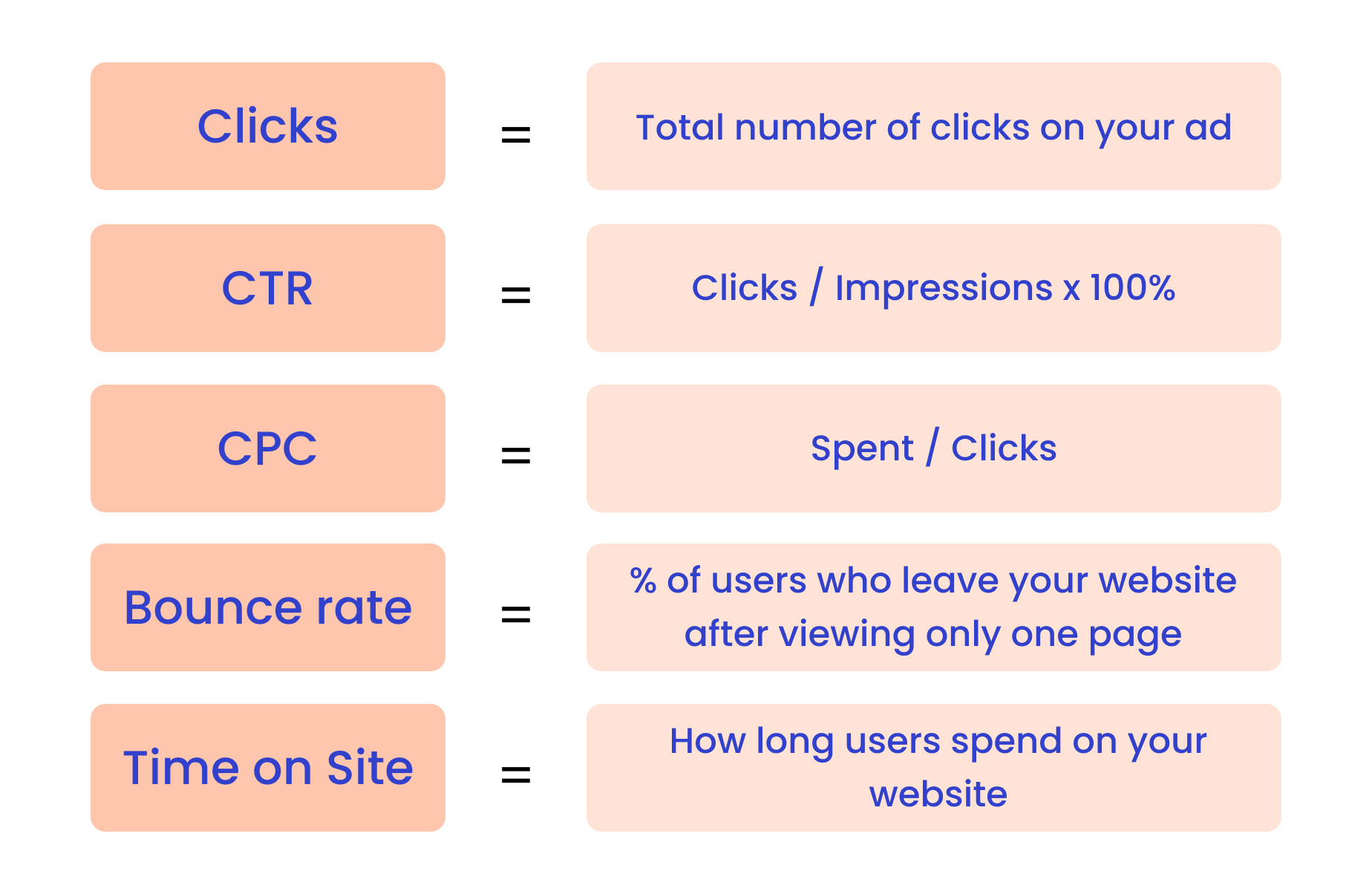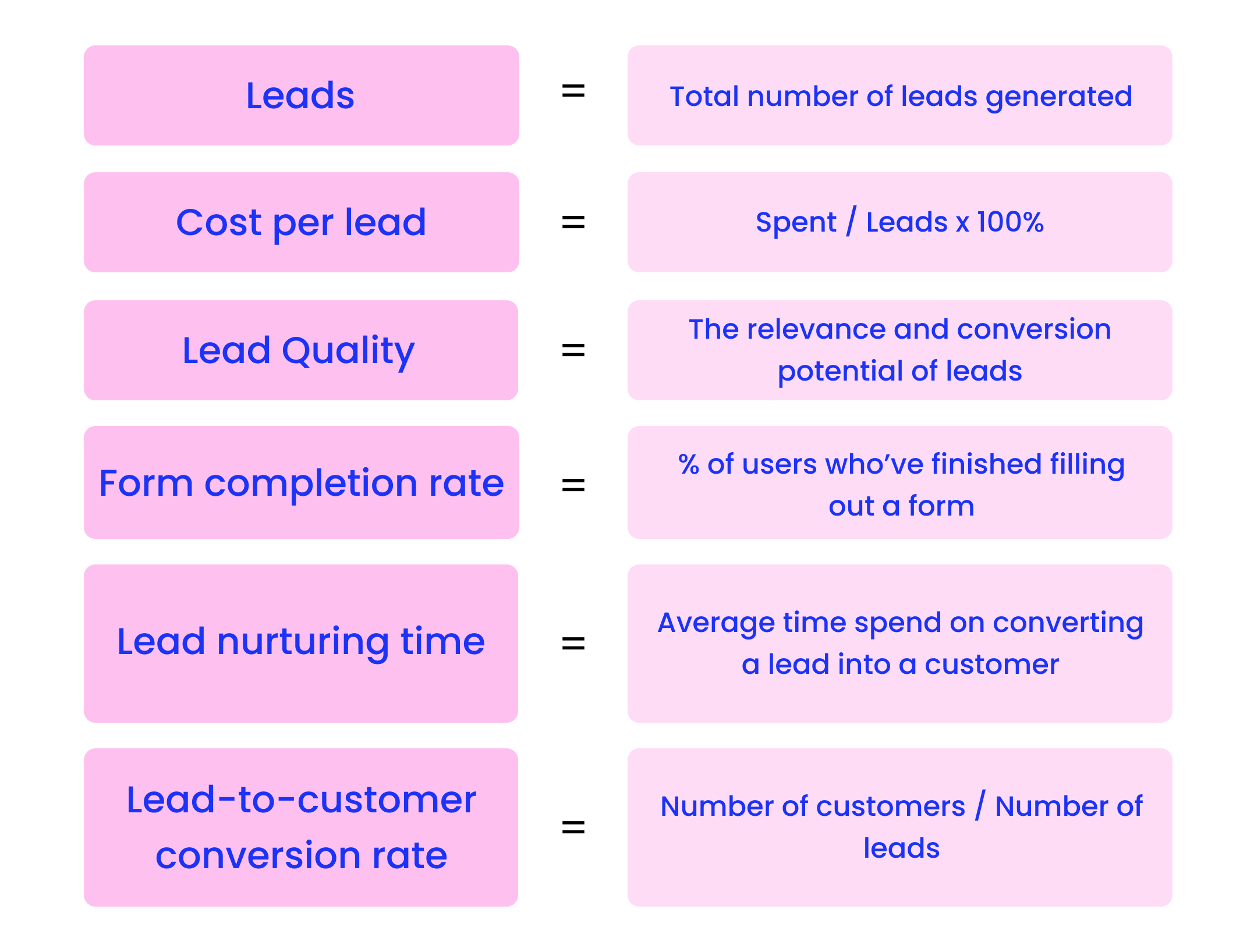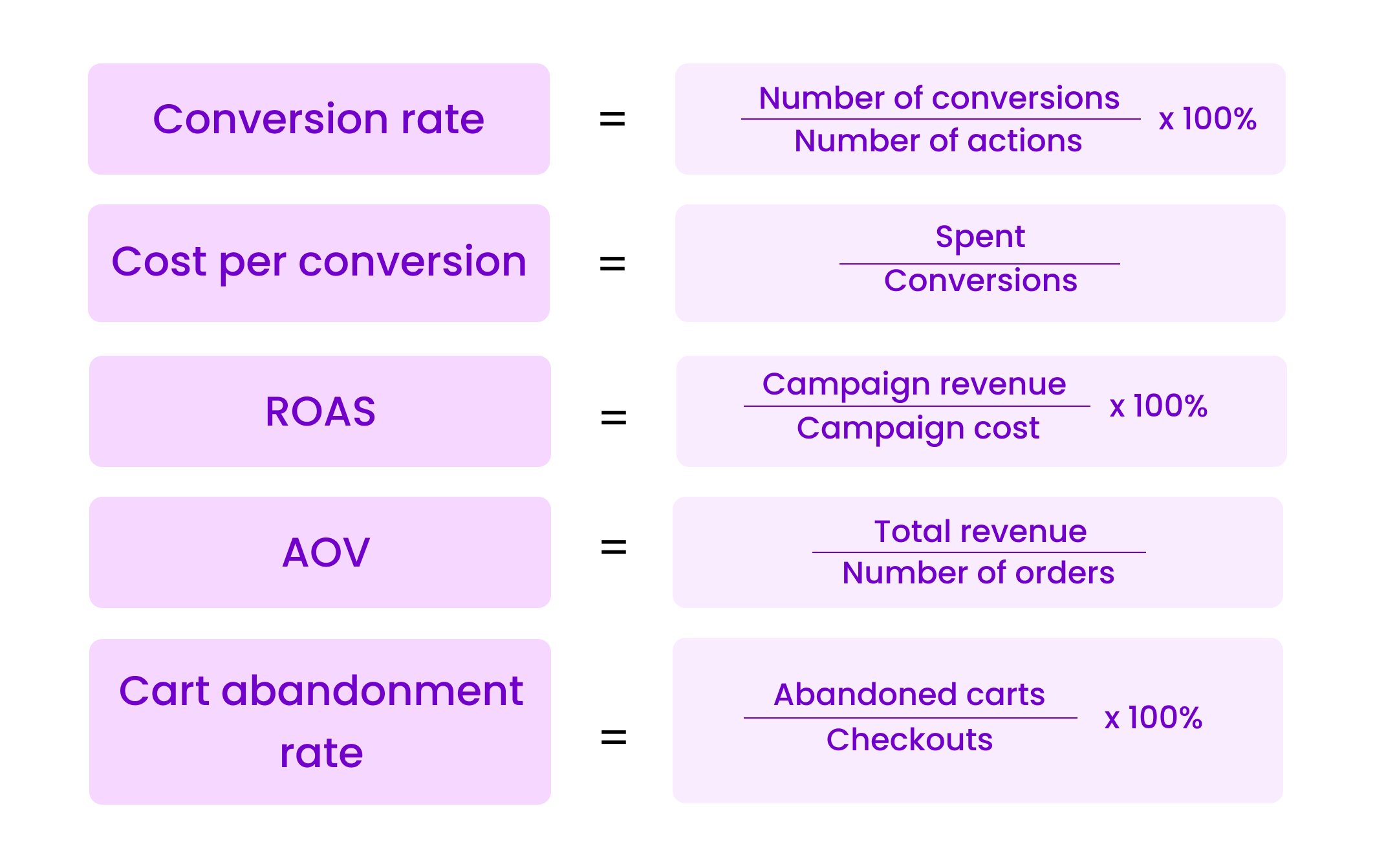Tracking Advertising Metrics and KPIs: The Key to Achieving Success
2024-06-26

When you’re out there promoting your own or your client’s business, getting a handle on advertising metrics is more important than it may seem.
Whether you're running awareness, consideration, or conversion campaigns, keeping an eye on the right numbers can make all the difference. So, let's break down the key performance indicators (KPIs) and metrics you need to know about, why they're so crucial to track, and which ones should be on your radar depending on your goals.
Why metrics and KPIs matter in advertising
In the past, businesses often guessed whether their advertising was working. Now, thanks to all the knowledge available to us, we can measure success accurately through various metrics and KPIs.
Here’s how these metrics and KPIs help us:
1. Guiding smart decisions
Metrics and KPIs act like a compass for advertisers: they help us see what's working well and where we can do better. By analyzing key indicators, we can understand what’s performing well and what needs improvement, making decisions based on objective data instead of intuition. Metrics give us a clear picture of how our campaigns are doing in relation to our goals.
2. Identifying opportunities for optimization
Metrics also help us find areas that need attention by guiding us toward underperforming areas with room for improvement. This allows us to refine our strategies, identify specific issues to address, and make necessary adjustments to boost overall ad performance.
3. Proving value and using resources wisely
One big advantage of metrics and KPIs is their ability to measure how well advertising efforts meet specific goals. You can track metrics like return on advertising spend (ROAS) or return on investment (ROI) to get proof that your campaigns are working and delivering the desired results. By keeping an eye on KPIs, you can show the impact of your efforts on your clients: metrics show the value and effectiveness of our advertising strategies and initiatives, which is crucial for making informed decisions and planning properly.
4. Driving long-term growth
How can you know that your advertising campaigns help your or your client’s business in the long run? You do that by tracking the dynamic of business growth in terms of specific results (like sales or revenue) and attributing them correctly to specific campaigns.
So, regularly checking advertising metrics and KPIs helps you see whether a business is growing or not and what drives the growth. It also helps you adapt quickly to changes in the market and customer behavior, as the metrics follow suit and either grow or decline. This is the key to staying competitive and achieving lasting success in the world of digital advertising.
In short, metrics and KPIs are crucial for understanding how well your ad campaigns are doing and what course of action to take. They help you decide whether to spend more money on your campaigns, optimize and change them, or even stop them when the results aren’t looking good.
For example, if your or your client’s PPC campaigns are doing better than expected and you see that based on certain metrics, it might be time to increase the spending to get even better results. If the campaigns get a lot of likes or other engagement actions but not many clicks or sales (and that’s your primary goal), it might be time to check why that happens.
Now, let’s consider specific metrics and KPIs that you can track when running your advertising campaigns.
Understanding advertising metrics and KPIs
It can be easy to lose track of what really matters because there are just too many KPIs and metrics. You might be wondering which metrics you should pay attention to, and which of them aren’t that important.
The best solution to this dilemma is getting clear on what you’re trying to achieve with your ad campaigns, i.e. the objective you’re pursuing.
Without further ado, let’s go through the main types of ad campaigns you can run and their corresponding metrics and KPIs. If you’re running ad campaigns on Meta platforms (Facebook, Instagram, Messenger Network, etc.), check out our article on new Meta campaign objectives to know your options.
Reach campaigns
If you’re running campaigns aimed at getting more users to visit your website, here are the metrics you want to keep an eye on:
Impressions
Tracking impressions is crucial because it shows how many times your ad has been displayed (but not interacted with). More impressions mean that your ad is seen by more people. This metric helps you gauge the initial exposure of your ad campaign and assess its potential reach among your target audience.
Reach
Unlike impressions, reach measures the unique number of users who have seen your ad. It's essential because it gives you insights into the actual size of your ad's audience and helps in estimating the campaign's overall impact.
Frequency
Monitoring frequency helps you manage how often your ad is shown to users within a specific time frame. It's important to balance frequency to avoid ad fatigue (where users get tired of seeing the same ad) while ensuring that your message is effectively communicated and people remember your ad.
Ad Recall Lift
Measuring ad recall lift indicates how well your ad resonates with users and how memorable it is. A higher ad recall lift means that your ad is making a lasting impression and increasing brand awareness among your audience.
Cost per Thousand Impressions (CPM)
CPM helps you understand the cost efficiency of your ad campaign in terms of showing your ad 1,000 times. A lower CPM indicates that you're getting more impressions for your budget, which is beneficial for maximizing reach without overspending.

Why should you track reach metrics?
- Assessing initial exposure: impressions and reach metrics can provide you with the foundational data to understand how many users have been exposed to your ad campaign initially;
- Optimizing frequency: monitoring frequency can help you ensure that your ad is visible enough to make an impact without overwhelming users with repeated exposures;
- Measuring brand impact: metrics like ad recall lift can show you how well your ad is remembered, helping you gauge its effectiveness in creating brand awareness and recall;
- Cost efficiency: CPM and other cost-related metrics help you evaluate how efficiently you're reaching your target audience. Lower CPM can indicate better cost management and more effective campaign planning.
Engagement campaigns
If the primary goal of your ad campaign is to get people to interact with your ads, here’s what you want to pay attention to:
Likes, shares, and comments
Tracking social interactions like likes, shares, and comments helps check how engaging your ad content is. It indicates how well your ad resonates with your audience and helps you see if something about your ad (like ad messaging, copy, visuals, or other elements) should be changed.
Clicks
The number of clicks shows how many users are actively engaging with your ad by clicking on it. It's a direct indicator of user interest and intent to learn more about your products or services. The more relevant your ads are, the more clicks you’ll get.
Engagement rate
Calculating the engagement rate shows you the percentage of users who’ve interacted with your ad out of everyone who saw it. It reflects the ad's ability to not only catch your audience’s attention but also make them interact with it.
Video views
For video ads, tracking views (including full views, 3-second views, etc.) helps you check how well your video content captures and retains viewers' attention. Basically, it's crucial for assessing video ad performance and finding out if you need to change the visuals, the length of the video, or other elements.

Why should you track engagement metrics?
- Measuring engagement: engagement metrics provide insights into how well your ad content resonates with your audience and whether it encourages them to interact with your brand;
- Understanding user behavior: clicks and engagement rates indicate user intent and interest, helping you tailor your ads to better fit your audience’s preferences;
- Optimizing content: tracking video views and interaction rates helps you optimize your video ad content by understanding what elements capture and hold users' attention.
Traffic campaigns
The main purpose of traffic campaigns is to drive users to your website or a specific landing page. If that’s what you’re after, make sure to track these metrics:
Clicks
Tracking clicks helps you measure the number of users who visit your website or landing page after clicking on your ad. It's a primary metric for evaluating how well your ad drives traffic and user interest: if no one is clicking on your ad, it’s a signal to change something.
Click-Through Rate (CTR)
CTR calculates the percentage of users who clicked on your ad after seeing it. It shows the relevance and effectiveness of your ad copy and creatives in driving clicks: the better your ads fit your target audience’s pain points and needs, the higher your CTR will be.
Cost per Click (CPC)
CPC measures the average cost for each click on your ad. It helps you assess your campaign’s cost-efficiency and determine how much you need to spend to generate traffic to your website. If you see that your cost per click is too high, it might mean that you need to revise your strategy and fix what’s driving higher costs.
Bounce rate
The bounce rate indicates the percentage of users who leave your website after viewing only one page. A lower bounce rate means that users find your landing page relevant and engaging enough to keep exploring it, while a high bounce rate can signal a mismatch between the content of your website and the offers in your ad, poor navigation, slow loading speed, and so on.
Time on Site
This metric measures the time users spend on your website after clicking your ad. It helps you check the level of user engagement with your website’s content and assess the quality of traffic driven by your campaign. The more time users spend on your website, the higher the likelihood of them converting.

Why should you track traffic metrics?
- Driving qualified traffic: clicks and CTR show how effective your ads are in generating user interest and driving traffic to your website;
- User engagement: metrics like bounce rate and time on site provide insights into user engagement, relevance of your landing page or website content, and other aspects (load speed, navigation, design, etc.);
- Conversion potential: monitoring various traffic metrics helps you identify opportunities to optimize landing pages and the user experience to improve conversion rates;
- Cost efficiency: CPC and CTR help you assess the campaign's cost-effectiveness and allocate your budget to ads and campaigns that deliver better results at lower costs.
Leads campaigns
Lead generation campaigns are essential when you’re working on populating your conversion funnel with new potential customers. Here are the metrics you want to track for this type of campaign:
Leads
The total number of generated leads shows how effective your campaign is in attracting new prospects for your business. As leads are potential customers, you want to get as many as possible to start building a relationship with them. Note, however, that it’s not only the quantity that matters when we’re talking about leads.
Cost per lead (CPL)
CPL calculates the average cost of each lead you acquire through your ads. It helps you assess the efficiency of your lead generation campaign and determine the cost of generating new leads, allowing you to plan your budget accordingly. Ideally, you want to achieve an optimal CPL that balances the quality of the leads you generate with how much you spend on each of them.
Lead quality
This is by far one of the most important, even if hard to accurately calculate, metrics in lead generation. It can be based on demographics, behaviors, engagement, and other factors that show how likely the generated lead is to turn into a paying (and, what also matters a lot, loyal) customer. Prioritizing high-potential leads for further nurturing and conversion is essential for running lead gen campaigns that work for increasing your business’ ROI, not just the number of people in your CRM.
Form completion rate
This metric measures the percentage of users who start filling out a form and complete it. It shows the effectiveness of your lead capture process, e.g. how well-made your lead forms are. If this rate is low, you might want to consider finding alternative ways to make people submit their information to you or provide additional incentives for them to do so.
Lead nurturing time
Lead nurturing time tracks the average time it takes to convert a lead into a paying customer. Shorter nurturing times indicate effective lead nurturing strategies and quicker conversion paths, but this may vary depending on the type of business you’re running. For example, lead nurturing time can be longer for B2B businesses.
Lead-to-customer conversion rate
This metric measures the percentage of leads that eventually convert into paying customers. It shows the overall effectiveness of your lead generation efforts: the better you are at finding high-quality leads and nurturing them, the higher this rate will be.

Why should you track lead generation metrics?
- Lead generation effectiveness: conversion rate and CPL metrics help you assess how well your campaign generates qualified leads and converts them into potential customers. If those numbers are suboptimal, it’s time to re-evaluate your campaigns;
- Optimizing lead quality: tracking lead quality allows you to ensure that you focus on leads with the highest potential to convert, improving overall sales and revenue generation;
- Refining lead capture: form completion rate and lead nurturing time metrics reveal when it’s time to optimize your landing pages and lead capture algorithm to increase conversion rates;
- ROI measurement: monitoring lead-to-customer conversion rates and overall lead generation costs helps you calculate the ROI for lead-gen campaigns and optimize budget allocation for better results.
Conversions campaigns
The goal of this type of campaigns is to generate a specific kind of conversions: sales, app installs, subscriptions, and so on, depending on the product or service you’re advertising. When you run conversion campaigns, you need to pay attention to the following metrics:
Conversion rate
The conversion rate shows the percentage of users who complete specific actions (like making a purchase or downloading your app) after interacting with your ad. It measures the success of your campaign in achieving the desired goals: a high conversion rate means that your strategy is working.
Cost per conversion
This metric calculates the average cost per conversion, indicating the efficiency of your campaign in driving desired actions. A lower cost per conversion indicates better campaign performance and a higher ROI, while a higher one means that there can be some obstacles that prevent more people from converting.
Return on Ad Spend (ROAS)
ROAS measures the revenue generated for every dollar spent on advertising. It helps you evaluate the profitability of your conversion campaigns and optimize ad spend allocation, channeling more money to campaigns with higher returns.
Average Order Value (AOV)
AOV shows the average amount spent by customers per transaction. A higher AOV indicates higher spending per customer, which usually means that the items you sell help solve the problems and satisfy the needs of your target audience.
Lower AOV might show the preference of your customers only for specific categories of items: they buy only certain products (for example, the ones that are cheaper) while not paying attention to the rest of what you have to offer. In this case, special deals and discounts can help you increase the average amount of money spent by your customers.
Cart abandonment rate
This metric measures the percentage of users who add items to their cart but do not complete the purchase. Lower abandonment rates indicate a more effective sales funnel and checkout process, while higher rates can signal various issues, starting from high prices and and a lack of delivery options to technical bugs that may prevent people from completing the purchase.

Why should you track conversion metrics?
- Goal achievement: conversion rate and cost per conversion metrics directly measure your campaign's success in driving specific actions and achieving desired goals;
- Financial impact: metrics like ROAS provide insights into your campaign's contribution to overall revenue and profitability;
- Optimizing customer value: AOV and cart abandonment rate metrics help you identify opportunities to increase average transaction values and reduce lost sales;
- Campaign efficiency: monitoring these metrics allows you to optimize bidding strategies, refine targeting, and improve ad creatives to maximize campaign efficiency and ROI.
How to choose the right advertising metrics and KPIs to track?
Choosing the right metrics and KPIs is crucial for measuring the success of your ad campaigns. Here are the key tips for making the right choice:
- Understand your campaign goals: know what you want to achieve. Is it more traffic, sales, or simply brand awareness?Clear goals help you choose the right metrics to track;
- Align metrics with goals: match your metrics to your goals. For example, if you want more website visitors, track metrics like traffic and click-through rates;
- Focus on actionable metrics: choose metrics that give you insights for making important decisions. Avoid vanity metrics that only look good in theory but don’t actually reflect the results that help you evaluate the effectiveness of your campaigns;
- Keep it simple: avoid tracking too many metrics as this can quickly lead to burnout and make you lose focus of what really matters. Focus on the most important metrics that are tied to the specific goals you’re trying to achieve;
- Use benchmarks: compare your metrics against industry standards and the results of your previous successful campaigns. Benchmarks allow you to understand how well your ads are performing based on data that makes sense for the specific case you’re dealing with;
- Monitor and adjust: regularly check your metrics in the dashboards of the advertising platforms you’re using or through third-party tracking tools. Adjust and calibrate your strategy based on what the data tells you.
Recap
As the saying goes, knowledge is power. And in the world of advertising, knowledge comes not only in the form of expert tips and innovative strategies, but also good old numbers – the metrics and KPIs that help you measure your successes and failures.
The metrics and KPIs we’ve discussed in this article can help you accurately track ad performance and make data-based decisions, ensuring that every dollar spent on advertising is used effectively. So, start tracking the right metrics today to unlock the full potential of your advertising efforts and stay ahead of your competitors.
If you want to go even further, explore how ConvertBomb can help you automatically manage and optimize your ad campaigns based on different metrics: sign up for a free trial and let the algorithms do the manual work for you.

